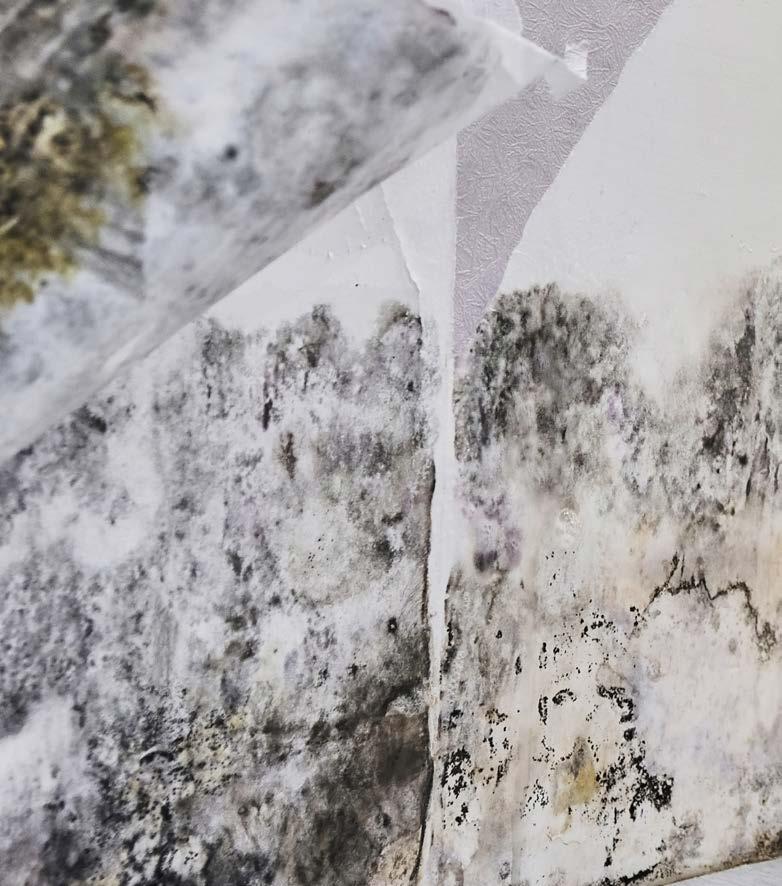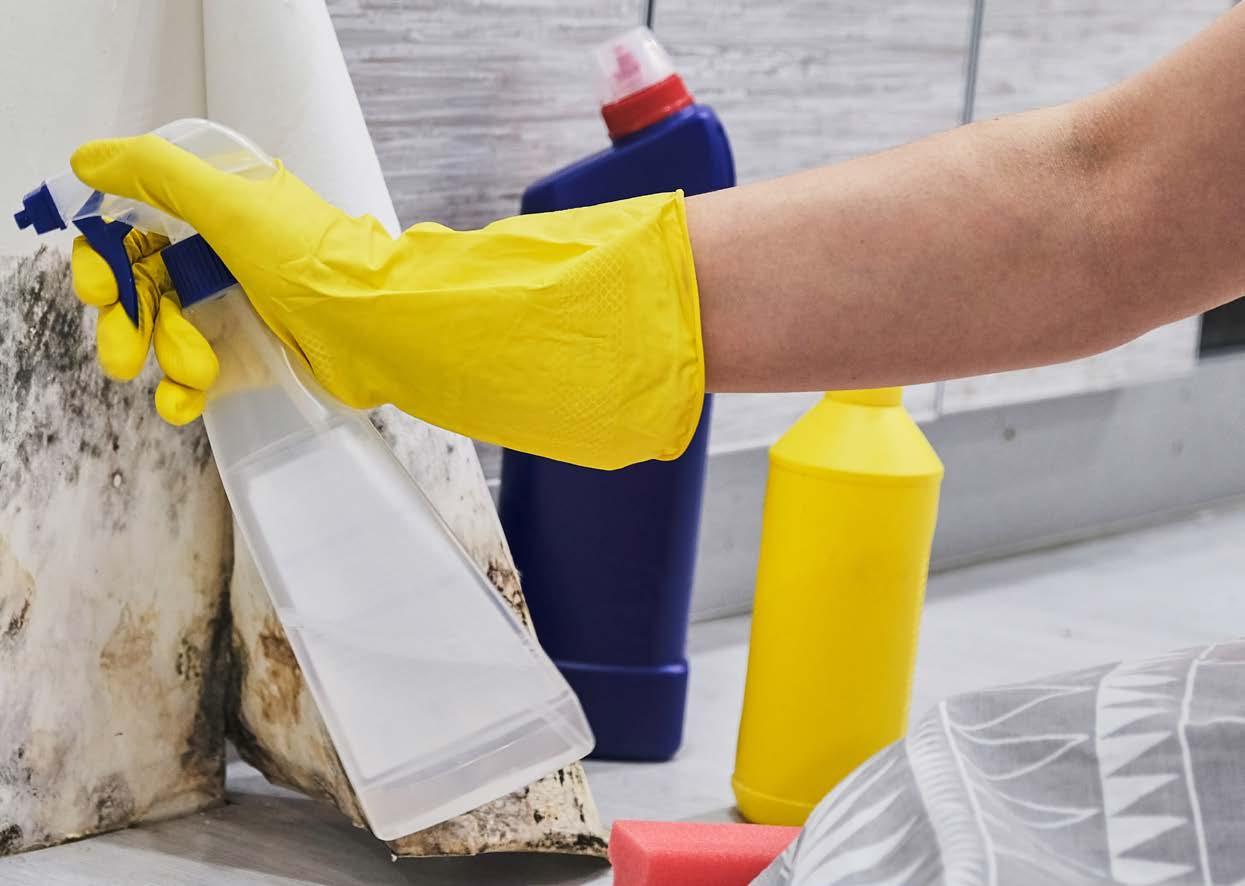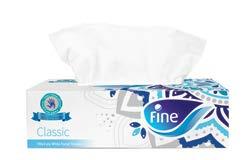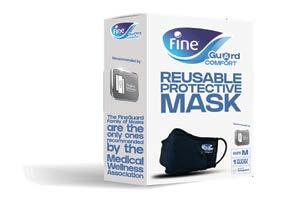
15 minute read
HOME HYGIENE
In this issue, we look at teaching children about various hygiene practices and the hazards of damp in the home. TEACHING CHILDREN ABOUT HYGIENE
It is more important now than ever before that children understand what hygiene means and why it is so necessary. Here we look at some of the key things children should know.
FOOD HYGIENE When you are teaching your children about food hygiene, start with the basics and talk to them about germs and bacteria. Explain to them how quickly bacteria can spread from their hands to the food and into the mouth or nose. Here are a few food hygiene habits that you should teach your child.

} Always wash hands with soap and clean water before touching or handling food
} Rinse and rub soap for at least two minutes
} Always wash hands before and after eating, especially if they have been to the toilet or were playing outside
} Clean hands thoroughly so that there are no traces of soap left
} Wash your hands frequently when helping in the kitchen, as vegetables, raw meat and chicken may be carrying bacteria before they are cooked
and mouth } Teach your children to put the lid back onto food containers if they are taking something from the fridge } Instruct your children never to put dirty hands in mouth, bite nails, or wipe their face or eyes with filthy hands. BODY HYGIENE FOR KIDS One of the most important aspects of personal hygiene is taking care of your body. Body hygiene is about keeping every part of your body clean to stay healthy and presentable. Healthy body hygiene habits include taking care of the skin, hair and feet. Here are a few ways in which you can teach your kids to keep their body clean. } Teach them how to clean the different parts of the body – the hands, armpits, legs, feet, groin, joints, back, belly button (navel), elbows and knees. Show them how to do it and then let them practice it.
} Make sure that they use soap for bathing and pat dry their body after bathing.
} Take extra care when teaching them to clean their face – make sure they clean their ears and neck, which they may overlook.
} Children tend to finish off bathing quickly, so make sure they spend enough time taking a bath. Also, reward them every time they bathe properly.
ORAL HYGIENE
Oral hygiene is as important as hand hygiene or skin hygiene in children. An unclean mouth can give out bad odour and cause cavities, which can be avoided when children have good oral hygiene. Tips to encourage them to keep their teeth and mouth clean include:
} Make sure your child brushes twice daily and cleans even the corners of their mouth thoroughly
} Teach them how to floss and remind them to do it each time they brush
} Ask them to wash their mouth with water after food or after eating sweet or sugary foods
} Schedule a dentist visit once every six
} Always use a clean cloth to wipe your hands
months. HYGIENE AT HOME
In addition to personal hygiene, children should also be taught to maintain hygiene when they are at home. Here are a few things you can teach them to do.
} Tell them to keep their room clean and keep everything in its place
} Teach them from the earliest age you can to put their bowl or plate in the sink after they eat a meal, and wash their hands after eating
} Teach them to clean up if they spill or drop something on the floor or any other surface.
If your child is too young to be able to clean it, help them do it
} Let them follow basic toilet and bathroom cleanliness standards – they must flush the toilet after use, use the bathroom supplies, throw used tissues or other garbage in the bin, etc.
You cannot teach your kids these basic personal hygiene habits overnight. Developing healthy habits is a process that takes time and should be handled with lots of patience.دصد

WHY DAMP IN YOUR HOME AFFECTS YOUR FAMILY’S HEALTH
Living with mould and damp in your home is not only unsightly and unpleasant, the health risks can make your home a more hazardous place to live.
To understand how damp and mould affects your family’s health, it’s important to understand what mould and damp actually are.
What is Damp? Damp is caused by an excess of moisture in a building. This excess moisture is either making its way inside your property from the outside (penetrating damp / rising damp), or from moisture within the home from condensation, a leaky pipe, or poorlymaintained sealants - such as around the shower, sinks or the bath. Poor ventilation, excess moisture and poorly air conditioned homes are common causes of condensationrelated damp.
Damp or humid conditions are perfect conditions for mould to grow.
What is mould? Black mould is a type of fungus that grows and develops in damp or humid conditions. Depending on how serious the mould infection is, it can vary in appearance. Black mould starts to produce spores - these allow mould to keep reproducing and growing. They are responsible for most health problems caused by damp and mould in the home.
What are mould spores? Mould spores are tiny structures produced by mould in order to reproduce and grow. They’re incredibly small - half the width of a human hair, which means they can float in the air unseen.
These spores are allergens, which means they can cause various allergic reactions. That’s why inhaling or touching mould spores can cause health issues or make existing conditions worse.
BLACK MOULD & FAMILY HEALTH Contact with mould spores can leave you or your family more susceptible to developing a range of different health conditions such as respiratory problems, which are a common complaint from those living in mouldy environments. Symptoms can include trouble breathing, a tight chest, coughing and wheezing. These symptoms are usually mild but can become chronic if you’re exposed to mould spores over a long period of time.
General respiratory problems can sometimes develop into more complex respiratory infections and leave you more vulnerable to other bugs and viruses.
More specific symptoms of a respiratory infection include:
} Coughing } Mild fever (more common in children) } A blocked and/or runny nose } Pain or pressure behind the face } A scratchy or sore throat } Sneezing
If you experience these symptoms over a long period of time, do mention to your doctor any damp or mould issues in your home, as they may well be the cause, or a contributory factor of your respiratory problem.
Can mould cause asthma? A common concern about mould and the respiratory system is whether mould exposure directly causes asthma. Mould spores themselves cannot cause asthma, however, if you already suffer from the condition and have an allergy to mould, exposure to mould spores can cause more frequent and serious asthma attacks.
Skin conditions caused by mould in the home Another common health issue caused by mould spores in the home is skin rashes, which can be caused by an allergic reaction to mould spores. This allergic reaction can affect people who are already prone to skin breakouts, such as those suffering with eczema, as well as individuals who don’t have an underlying skin condition.
Allergic skin rashes commonly present as:
} Dry, red and cracked skin } A raised, itchy, red rash (hives)
} Itchy, red, watering eyes (conjunctivitis) If you are concerned about your or your family’s health and the potential impact of mould, go and see your doctor, as well as tackling the root cause by contacting a firm that specialises in damp treatment and removal.
Mould and mental health Living with mould doesn’t just have an effect on physical health. A study in 2007 also found a connection between damp, mouldy homes and depression.
The stress of living in a mouldy home can be high. There is the damage to your possessions, the unattractive appearance and smell, and the concerns around its impact on your health and that of your children. Some people may feel overwhelmed by it, or may not see a clear resolution, or are concerned about the financial costs.
More recent research also suggests that mould toxicity, a condition that occurs when mould toxins accumulate in the body, can also lead to symptoms of depression, anxiety, attentional problems, brain fog and insomnia. This suggests that some health issues associated with mould can be more difficult to detect than the more obvious physical symptoms - although equally as debilitating.
Who is most at risk from developing damp and mould-related health issues? Exposure to mould spores is not healthy for anyone and should be avoided as much as possible. However, there are certain groups of people who need to take extra precautions to avoid contact with mould because they’re more likely to be sensitive to the allergens.
Pregnant women and new parents should rightly be concerned about the impact of mould on their children. Babies and children are more vulnerable to mould, so you should do all you can to tackle it.
According to the healthcare experts, the groups of people most sensitive to allergens include:
} Babies and children } Elderly people } Anyone with existing skin problems, such as eczema } People with respiratory problems, such as allergies and asthma } individuals with a weakened immune
system It is important to be aware that baby cot mould is surprisingly common in damp family homes and dangerous for babies.
PREVENTING HEALTH PROBLEMS FROM DAMP AND MOULD There are many ways to tackle mould and damp in your home and protect your health. As damp and mould inside the home can be so serious, it is better to bring in a company that specialises in providing products and advice to prevent and counteract the effects of mould in your home.
Damp and mould in the bedroom Bedrooms are prone to mould because they’re more likely to suffer from condensation build-up. This is because bedrooms are often kept warm at night while breathing creates additional moisture. Mould in the bedroom can present a real risk to health simply because you spend a lot of time exposed to mould spores while you sleep during the night. If you’re more sensitive to mould allergens, this can be particularly hazardous. Either way, mould in the bedroom can take a toll on your health over time.

Removing and preventing mould in the bedroom If mould is growing on your bedroom walls, it may be tempting to wipe it away with some bleach or disinfectant. While this will improve the look of it, it does little to solve the actual problem. It is far better to contact a company that specialises in removing damp and mould at its cause.
Once removed, you can use various antimould products to help you prevent mould from re-growing in your bedroom. Ventilation is also key.
Damp and mould in the bathroom Due to the humidity of bathrooms, it’s very common for these spaces to develop damp and mould. A poorly ventilated bathroom encourages humid air to linger around and prevents wet surfaces from drying out - quickly leading to mould.
Although you spend less time in the bathroom than the bedroom, exposure to bathroom mould can still have a negative effect on your family’s health. It’s important to tackle the root cause of mould in the bathroom - condensation, which is best done with the help of experts in this work.
Controlling condensation to prevent mould
} Bathrooms and bedrooms are common spaces for mould growth. However, anywhere in the home can be affected.
Condensation is the most common cause of mould.

} Condensation occurs when moist air comes into contact with other air or surfaces that are at a lower temperature.
} To avoid condensation in the home you need to have a well-ventilated home, which can help you to reduce condensation through ventilation and avoid mould build-up, along with the health risks associated with it.
Penetrating & Rising Damp and Mould Water may be coming into your home from outside and causing damp issues, which could be due to a building fault, such as an upstairs apartment leak, poorly-sealed windows or doors - which will be more apparent in the winter months in this region. Common causes of penetrating damp in villas can include blocked gutters, failed render and faulty roofing. Before tackling the damp, you will need to uncover and resolve the underlying fault.
Rising damp is a comparatively rare form of damp that affects the walls of buildings. It occurs when moisture from the ground travels up through a wall, leading to damp issues. You will spot the warning signs on internal walls, often a visible stain known as a tide mark at the point where the water has reached.
Most buildings have a barrier that prevents water rising up in this way, however, this can either fail or be completely absent for various reasons. You’ll need to get help from experienced and qualified damp experts to either fix the problem or arrange a new barrier against the damp.
IMPORTANT ANNOUNCEMENT UPDATED ADVICE ON REDUCING VIRUS INFECTION RISK The important updated hygiene tips reproduced here are based on the recommendations of the Medical Wellness Association (MWA) and the Family Hygiene Institute (FHI). Their tips frequently emphasise the use of sterilized tissues and household toilet paper and paper towels.

The Medical Wellness Association (MWA) is a recognised international organisation for medical wellness professionals, and provides them with guidance on best practices, programmes, research, education and training. The Family Hygiene Institute (FHI) is a collection of health and medical wellness professionals operating under the MWA, whose purpose is to promote proven hygiene practices, in order to advance the health and wellness of families around the world. These are their updated recommendations, together with our recommendation of which products you can use to meet the recommended hygiene guidelines.
WASH YOUR HANDS REGULARLY AND DRY WITH
A STERILIZED PAPER TOWEL OR TISSUE
In bathrooms, we are used to seeing damp and used cloth towels to dry hands. However, these are a breeding ground for germs that you can easily spread from person-to-person.
NOTE: For safer hand-washing practice, wash your hands with an antibacterial soap, then dry them with a fresh, sterilized paper towel or tissue. (Covid-19 can live on unsterilized tissues for up to 3 hours, according to respected medical research journal, The Lancet, in their ‘Microbe 2020’ study.),
AVOID TOUCHING YOUR EYES, NOSE OR MOUTH, ESPECIALLY IN PUBLIC PLACES Your eyes, nose and mouth are entry points to letting germs and viruses into your body. While thorough hand washing should neutralize the threat of infection, you should still avoid touching your eyes, nose or mouth with your hands, especially when in a public place.
USE A STERILIZED TISSUE TO COVER YOUR
MOUTH AND NOSE WHEN SNEEZING OR
COUGHING
Make sure you cover your nose and mouth with a sterilized tissue, when coughing or sneezing. REMEMBER: Ordinary tissues are often manufactured under unsanitary conditions, and can be laden with germs and viruses. Given tissue products touch intimate parts of your body, it is important to choose your tissues wisely and use ONLY sterilized tissue products. NOTE: The word “Sterilized” should appear prominently on the tissue package.
CHOOSE YOUR HOME AND PERSONAL CARE
PRODUCTS WISELY
The article on page 17 points to research that has identified areas of the kitchen where fecal matter commonly finds its way onto light switches, kitchen surfaces and taps/faucets in the home.
NOTE: When buying products for personal care in the bathroom, or kitchen roll for the kitchen, make sure to choose antibacterial products that are sterilized, with hygiene as their key benefit. When you sterilise, you minimise the spread of germs and viruses.
WEAR AN EFFECTIVE DISINFECTANT FACE MASK AND GLOVES Probably the most important tools in the fight against infection are a face mask and a pair of gloves. However, most ordinary masks only filter dust and are not the most protective type you can buy.
NOTE: Fine Guard masks are the only safe antiviral masks in the region that kills 99.99% of viruses on contact.
The same is true for gloves. While ordinary gloves do well to protect your hands, they can still carry viruses on their surface, posing the risk of infecting anything you touch.
NOTE: Fine Guard Protective Gloves are the only antiviral gloves in the region, that kill 99.99% of viruses contact.

This is the Editor’s Top Pick for this issue. Fine EDITOR’S TOP PICK Hygienic Holding’s For This Issue products have done so much to contribute to infection control in the region, as well as providing very important safety products and advice - at a time when we most need both.




THE STERILIZED SOLUTIONS


FINE TISSUES ARE STERILIZED FOR GERM PROTECTION Your family’s eyes, nose and mouth are their biggest points of vulnerability for catching a virus. That’s why every Fine tissue undergoes our patented sterilization process, killing 99.99% of germs and viruses during our manufacturing process, to ensure superior protection for you and the family.
USE FACE MASKS THAT ACTIVELY KILL GERMS The most effective face masks are disinfectant or self-sterilizing face masks. The Fine Guard Mask is specifically designed for infection prevention, as it is the only mask that kills germs on contact.
BATHROOM & HOME HYGIENE MEANS STERILISATION Disinfection is the best prevention of infection. The Fine Super Towel Pro is a sterilized paper towel that is ideal for use in the bathroom to dry your hands instead of using cloth towels, which are proven to harbour germs very quickly. Fine Deluxe Toilet Paper is a safe, sterilized option for all the family, which is particularly reassuring when you have children at home.
PROTECTING YOU AND YOUR WALLET No matter how tight our spending gets, we should never compromise on the quality of the things that really matter. That’s why Fine has introduced bigger value packs, to help you save on all your hygiene needs. Bigger Packs = Bigger Savings.
SCAN TO BUY THE ONLY STERILIZED TISSUES NOW!






